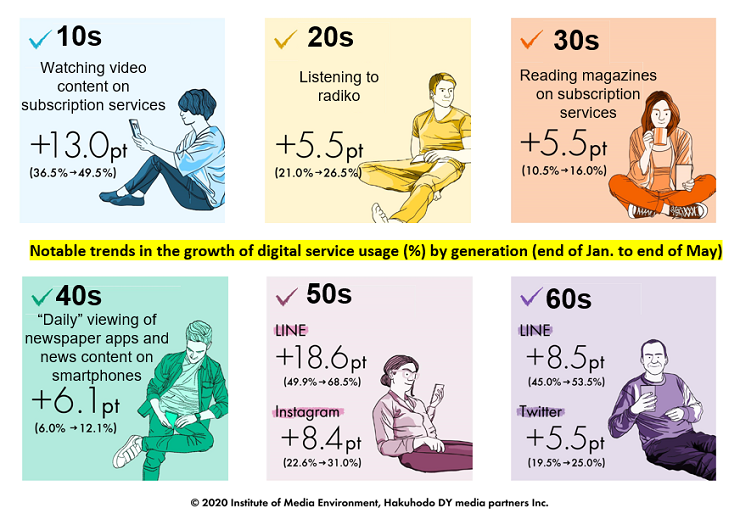Media Engagement Survey after the Lifting of the Emergency Declaration
7th July 2020
Hakuhodo DY Media Partners Inc.
Institute of Media Environment
Hakuhodo DY Media Partners Inc. (Now Hakuhodo Inc.) conducted a “Media Engagement Survey after the Lifting of the Emergency Declaration”
Changes in media life in response to the spread of COVID-19
It is noteworthy that the change was not related to “engagement time” but with “attitudes toward information” and “usage behavior”
・After the lifting of the state of emergency, media engagement time was at the same level as the end of January———-99.2%
・No change in engagement time, but change in attitudes toward information and media—–”Confronting” ”Verifying” ”Comforting”
・Increased in just four months—–Usage behavior of new digital media services
The Institute of Media Environment (Head office: Minato-ku, Tokyo; Director: Makoto Shimano) conducted a “Media Engagement Survey after the Lifting of the Emergency Declaration”.
The survey identified changes in people’s media consumption due to lifestyle changes in response to the spread of COVID-19.
This survey aimed to understand not only the temporary changes caused by the rising stay-at-home rate, but the “new normal of media”, the major media shifts that will continue in the future. The following are the three main findings.
①Media engagement time was 99.2% at the end of May, after the lifting of the emergency declaration. Not much difference compared to the end of January, which is taken as 100%.
Total daily media engagement time (for all people aged 15-69, in Tokyo) was compared between the end of January (when the situation was normal) and the end of May (after the lifting of the state of emergency). If the rate of January was set at 100%, that of May was 99.2%, therefore, it was found to be at almost the same level. During the stay-at-home period under the declaration of the state of emergency, it was reported that media engagement time and HUT increased due to more time indoors, however it appears that the change was temporary.
②The change was not related to time, but to attitudes toward information and media. ”Confronting” ”Verifying” ”Comforting”
During the pandemic, 60.2% of respondents “actively gathered information about COVID-19.” In the free answers, it was noted that there was a growing tendency to confront media information by confirming what was said at press conferences, making full use of various social networking services, and carefully following information scattered in various places in search of trust. There was a tendency to want to “verify” the quality of what was stated in the media and other information.
For example, 65.1% responded, “I have become more concerned about the reliability of what the media report“, and 47.5% stated, “I have become more concerned about the truthfulness and freshness of information.”
Standing out in the free answers, several respondents expressed a desire for “comforting” through heartwarming content via “radio, news anchors, and SNS influencers.”
Although calls for voluntary restraint on going out have been lifted, the pandemic is not yet over, and this attitude toward the media and information is expected to continue.
③Changes in the usage rates of subscription services, such as those for video content and magazines, radiko, newspaper apps, social networking, etc.
With the change in attitudes toward information, the adoption of new digital media services, which grew slowly over the past few years, has “accelerated” in just four months. Usage rates increased among all age groups. Future challenges include establishing new ways of being watched and listened to, changing communication by generation, and the commercialization of advertising.


